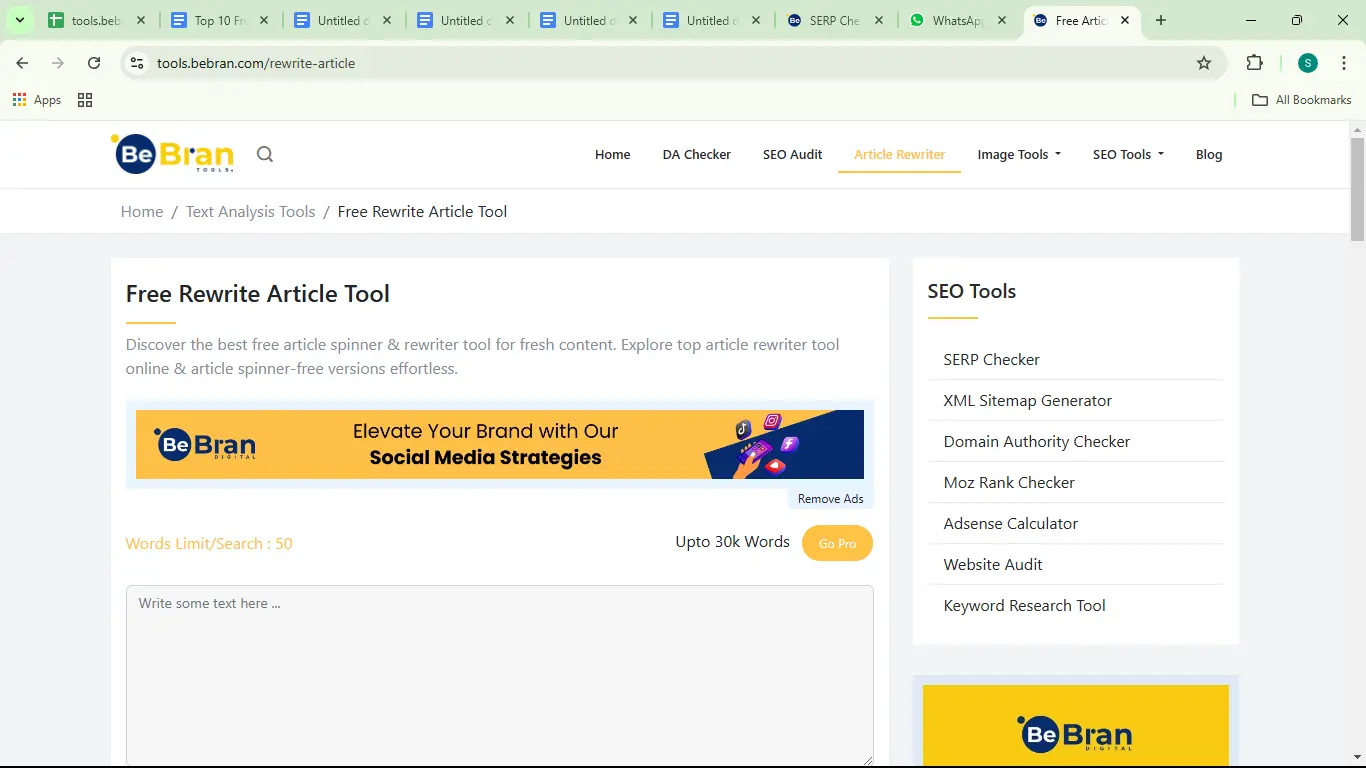
Avoiding Common Mistakes When Using Free Rewrite Article Tools
Free article rewrite tools are invaluable for content creators, marketers, and bloggers who need to generate unique, high-quality content efficiently. These tools allow users to repurpose existing material without starting from scratch, saving both time and effort. However, to truly harness their potential and ensure your rewritten content is impactful, thoughtful use is essential. When used without a careful approach, rewrite tools can lead to common issues like readability challenges, unintended changes in meaning, or even SEO problems that can affect your website’s ranking. Check out BeBran’s Free Rewrite Article Tool.

1. Over-Reliance on the Tool for Content Quality
While rewrite tools are powerful, they shouldn’t replace human judgment or quality control.
- Avoid Fully Automated Output: Rewriting tools often produce text that may sound unnatural or lack context. Always review and edit the output to ensure quality.
- Add a Personal Touch: Rewrite tools can produce basic versions, but adding unique insights, anecdotes, or examples enhances value and makes content more engaging.
- Check for Errors: Even advanced tools can create awkward phrasing or grammar issues. Proofreading is essential for clarity and flow.
2. Ignoring Readability and Engagement
Rewriting tools can inadvertently make text too complex or awkward if left unchecked.
- Focus on Readability: Always read through the output to confirm it’s easy to understand. Simplify sentences as needed.
- Use Subheadings and Bullet Points: Dense, rewritten text can overwhelm readers. Adding subheadings, bullet points, and short paragraphs improves readability.
- Ensure Natural Tone: Tools can sometimes produce formal or robotic language, which can make the content less engaging. Adjust the tone for a conversational, reader-friendly feel, especially for blog posts or articles aimed at general audiences.
3. Keyword Overload or Keyword Neglect
Using rewriting tools without an SEO strategy can lead to keyword stuffing or unintentional omission of essential keywords.
- Avoid Keyword Stuffing: Rewriting tools may retain keywords in repetitive ways, leading to keyword stuffing, which can negatively impact SEO. Ensure keywords are distributed naturally.
- Check for Primary Keywords: If important keywords are missing in the output, add them back in manually. Keywords should be used where they fit naturally.
- Incorporate Long-Tail Keywords: Rather than focusing solely on primary keywords, consider adding variations and long-tail keywords for better SEO performance.
4. Producing Duplicate Content
Rewriting tools can sometimes generate content that’s too close to the original text, leading to duplication risks.
- Run a Plagiarism Check: Always run rewritten content through a plagiarism checker to confirm its originality. This is crucial for SEO and content integrity.
- Use Synonyms and Paraphrasing: Ensure that the tool you’re using provides a range of synonyms and rephrases content enough to avoid duplication.
- Consider Structure Changes: Try changing the order of points or adding unique insights. This makes the content truly original and offers value beyond the rewritten version.
Free Tools: Free Related Keywords Finder Tool Online | Free Age Calculator Tool Online | Free Power Converter Tool Online
5. Choosing the Right Tool for Your Needs
Each rewrite tool has its own strengths, so choosing the wrong one can lead to disappointing results.
- Match the Tool to Your Content Goals:
- For quick, high-quality rewrites: BeBran’s Free Rewrite Article Tool is user-friendly and preserves context well.
- For formal or adjustable tone: QuillBot is flexible, allowing users to control creativity and tone.
- For bulk content or multilingual needs: SpinnerChief supports multi-language options.
- Experiment with Different Tools: Test multiple tools to find one that suits your content type, whether it’s blog posts, professional documents, or SEO-driven articles.

6. Neglecting Context and Meaning
Rewrite tools often rely on synonyms, which can change the intended meaning of phrases if not monitored.
- Check for Context Preservation: Read the output carefully to ensure it doesn’t misinterpret or change the original meaning.
- Use Tools with Contextual Understanding: Some tools, like QuillBot, have options for retaining context better than simpler tools.
- Add Personal Edits: If important points are altered, adjust manually to keep the content accurate and relevant.
7. Not Reviewing and Editing for SEO Optimization
While rewriting tools can generate unique content, they don’t automatically optimize for SEO unless you take additional steps.
- Review Meta Descriptions and Titles: Ensure each piece of rewritten content has a unique meta description and title if it’s going on a website. Tools can assist with rewriting these but won’t add SEO-specific elements.
- Optimize Internal Linking: Rewritten content can be enhanced with internal links to related content on your site, boosting SEO and user engagement.
- Monitor Keyword Density: Too few or too many keywords can affect rankings. Manually check density for optimal placement and adjust as needed.
8. Using Rewritten Content without Adding Value
Simply rewriting content without adding value can result in bland or redundant articles.
- Enhance Content with New Insights: Adding fresh examples, updated data, or personal commentary makes the content more engaging and valuable.
- Consider the Audience: Customize rewritten content to meet your audience’s needs and expectations. This approach will set your content apart from similar articles.
- Add Visual Elements: Enrich rewritten content with images, infographics, or videos when possible. Multimedia elements increase engagement and make the content more visually appealing.
9. Forgetting to Test the Content’s Performance
Rewriting content without monitoring its effectiveness can make it hard to know if it’s truly contributing to your goals.
- Track SEO Performance: Use tools like Google Analytics to see how the rewritten content performs in search rankings. This helps identify what’s working and where improvements are needed.
- Evaluate Engagement Metrics: High bounce rates or low time-on-page metrics may indicate that the rewritten content isn’t resonating with readers.
- A/B Test Different Versions: Try different rewritten versions of the same topic and see which performs best in terms of engagement and SEO.
10. Relying on Rewrite Tools for Every Piece of Content
Overusing rewrite tools can lead to overly similar, uninspired content that lacks originality and creativity.
- Balance with Original Content: Not every piece needs to be rewritten. Mix in fresh, original content with rewritten articles to keep your site dynamic and engaging.
- Use Tools as a Foundation: Use rewrite tools as a starting point, but always add your personal insights to create truly valuable and unique content.
- Refresh Old Content Strategically: Use rewrite tools to update older, successful content, but be selective about when and where to apply rewritten content.
Final Thoughts
Using free rewrite tools can be a highly effective strategy for creating unique, SEO-friendly content efficiently, but avoiding common mistakes is key to ensuring high quality. By choosing the right tool, monitoring for readability and SEO, and adding a personal touch, you can maximize the potential of these tools while maintaining originality and value. Tools like BeBran’s Free Rewrite Article Tool, QuillBot, SpinnerChief, SmallSEOTools, and Wordtune offer diverse features to support your content strategy, allowing you to create meaningful, engaging, and optimized content without falling into common pitfalls.
Explore More: 5 Reasons Why a Spell Check is Essential for Error-Free Writing | Paraphrasing vs. Plagiarism: Ensuring Ethical Writing with Paraphrased Tools | Best Paraphrasing Tools for Writers in 2025
Frequently Asked Questions
1. What are the most common mistakes people make when using article rewrite tools?
Common mistakes include relying too heavily on the tool without reviewing the output, overusing keywords (keyword stuffing), and not checking for grammatical accuracy, all of which can impact readability and SEO.
2. How can I ensure the rewritten content doesn’t lose the original meaning?
After generating rewritten content, carefully review it to ensure key points and context remain intact. Tools like Bebran’s Free Rewrite Article Tool produce quality content, but a final review helps confirm accuracy.
3. Is it a mistake to skip manual edits after using a rewrite tool?
Yes, skipping manual edits can lead to awkward phrasing or errors that affect readability. Always review and polish the rewritten content to align it with your voice and style.
4. How can I avoid producing low-quality content with a rewrite tool?
To avoid low-quality output, start with clear, well-written original text, use the appropriate settings in the tool, and make any necessary adjustments afterward for clarity and flow.
5. Why is keyword stuffing a mistake when using rewrite tools?
Overloading rewritten content with keywords can make it sound unnatural and harm SEO rankings. Instead, ensure keywords are used naturally and sparingly to maintain readability and effectiveness.
6. Is it necessary to use a plagiarism checker after rewriting content?
Yes, even if you’ve rewritten content, it’s wise to run it through a plagiarism checker to ensure originality, especially if the content is for SEO or academic purposes.
7. Can relying solely on free tools like Bebran’s result in lower-quality content?
Free tools like Bebran’s are valuable for basic rewriting tasks. However, relying solely on them without reviewing the output or combining them with manual edits may lead to lower-quality content.
8. How do I avoid overly repetitive language in rewritten content?
If the rewritten content sounds repetitive, try breaking up long sentences or substituting synonyms manually. Varying sentence structure can make the content more engaging and dynamic.
9. Is it a mistake to ignore the tone and style of the rewritten content?
Yes, rewritten content should match the intended tone and style of your brand or audience. Adjust the output to fit the appropriate voice, whether formal, casual, or technical.
10. How can I avoid content that sounds too “robotic” or unnatural?
To avoid a robotic tone, look for sections with rigid or awkward phrasing and reword them to sound more conversational. Reading the text aloud can help identify areas that need a human touch.



